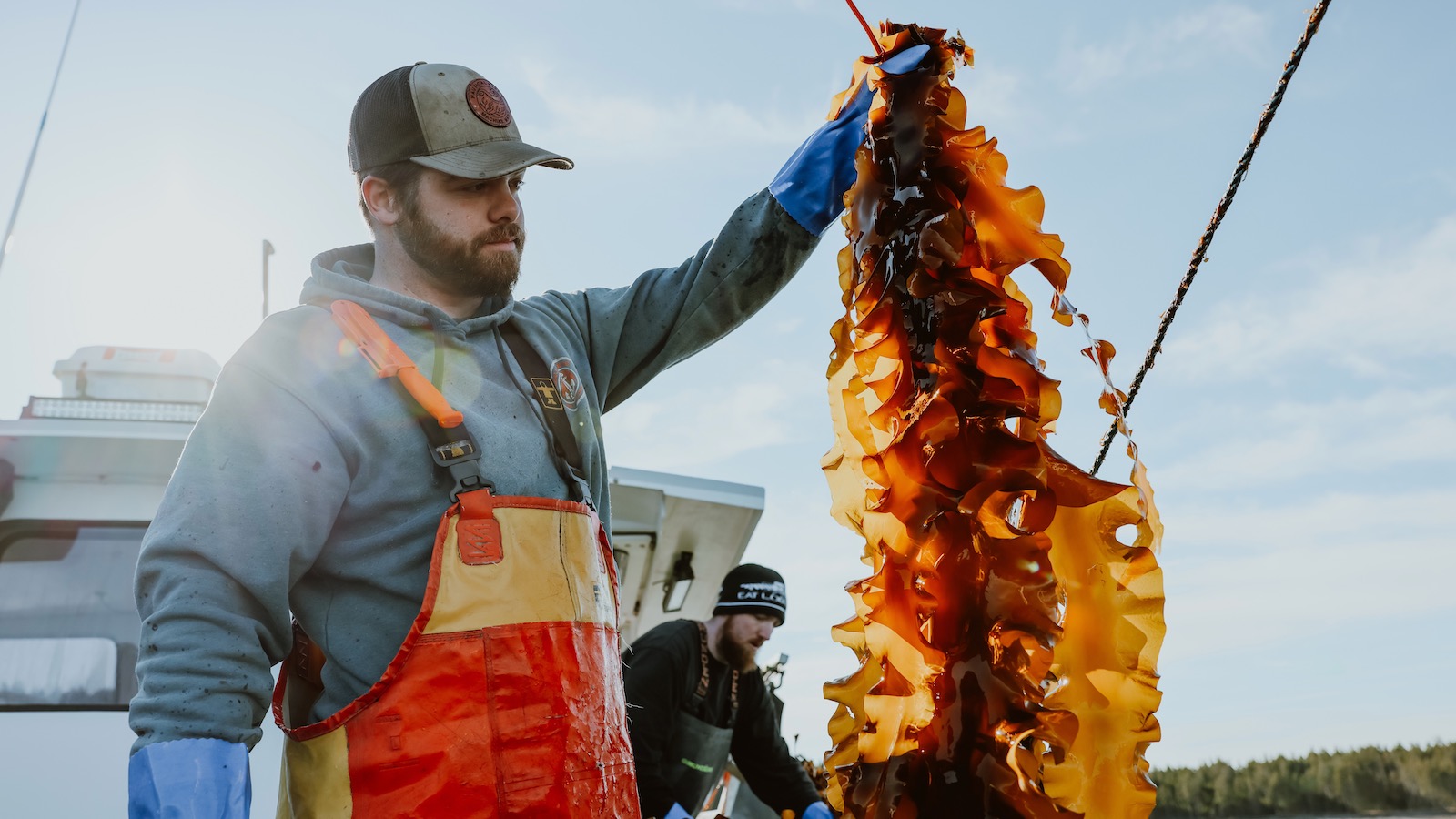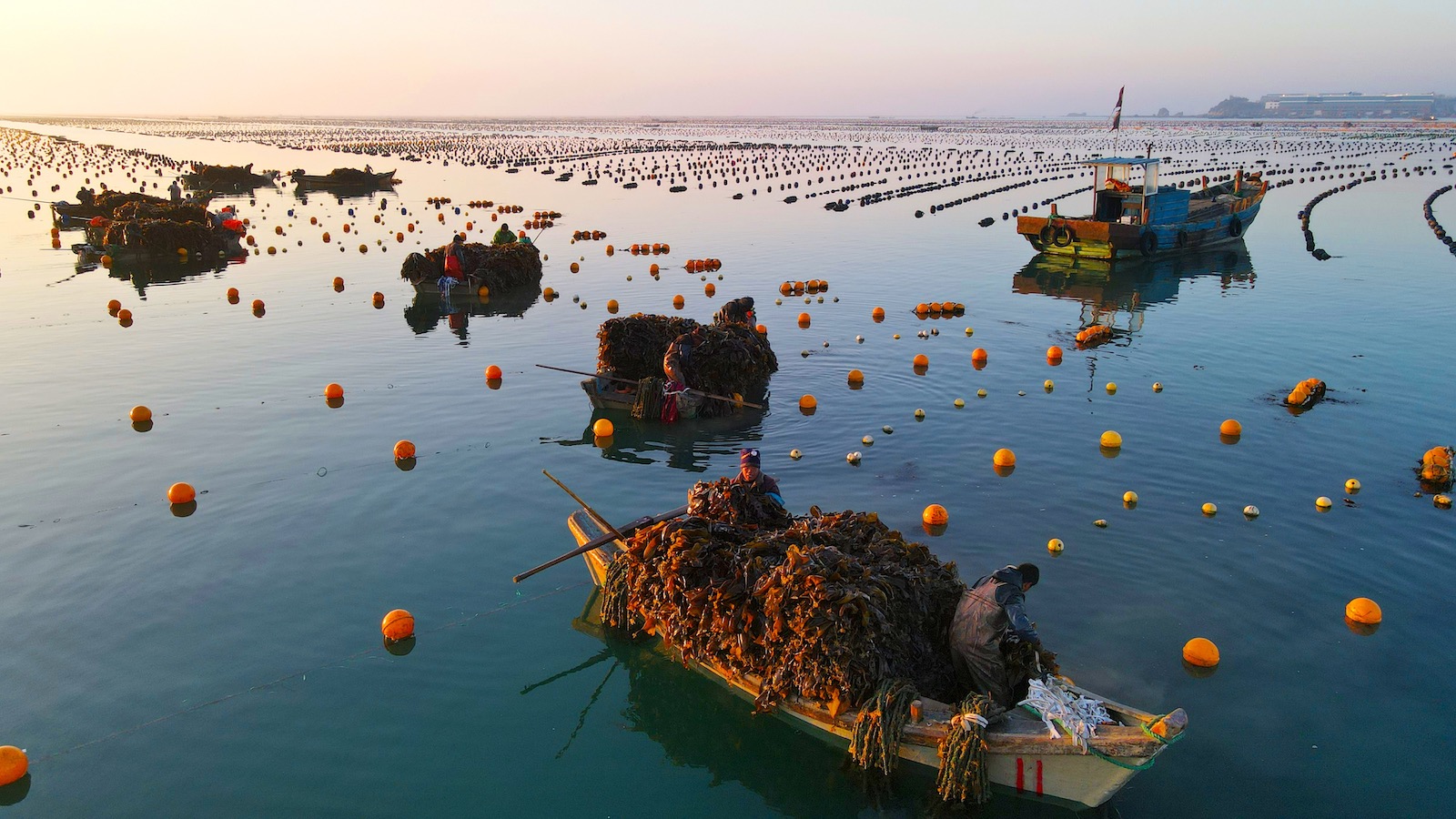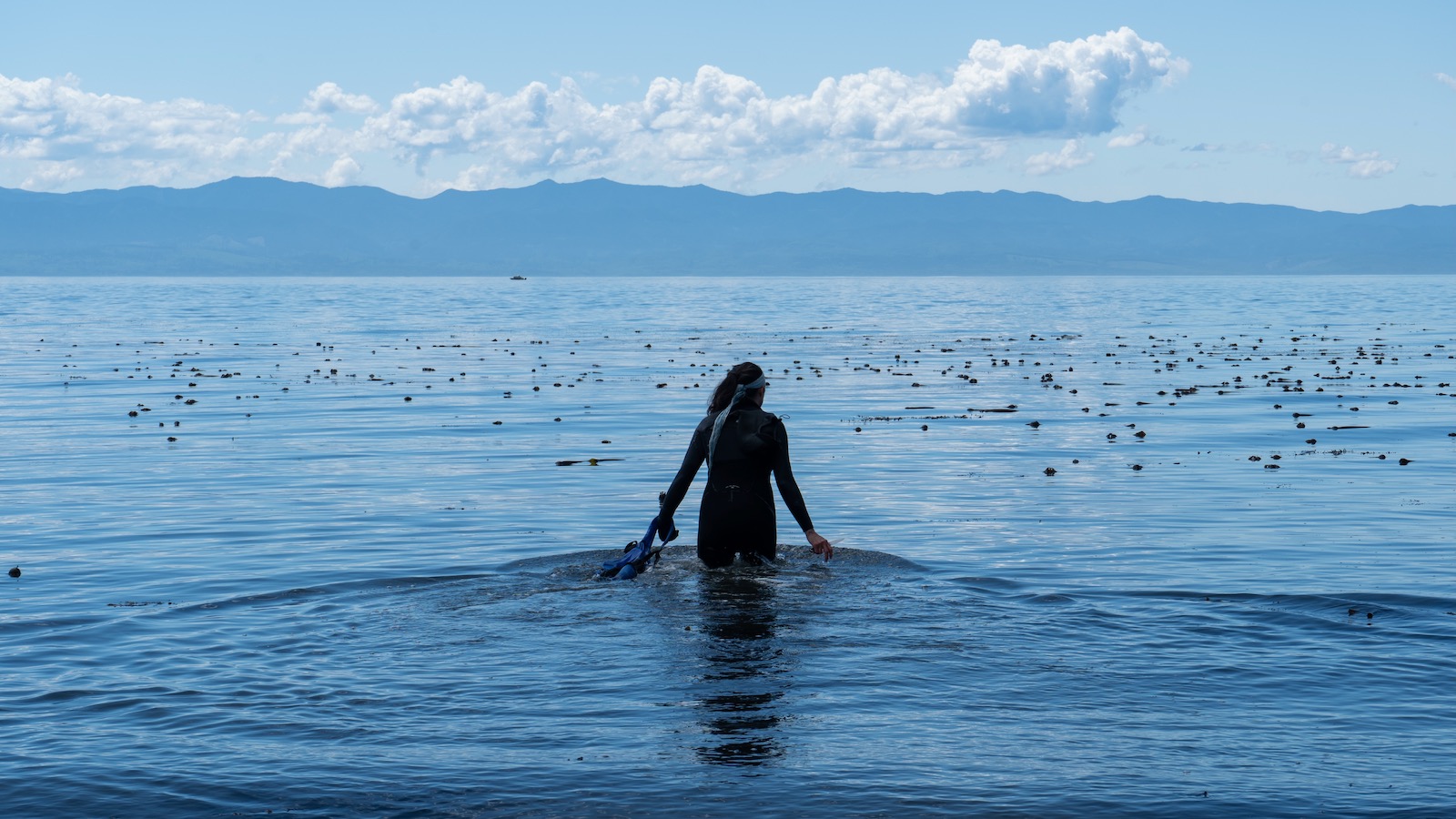
Cruising by on a boat, it’s easy to miss Jake Patryn’s farm, which looks like nothing more than an unassuming row of red and white buoys floating just off the coast of Machias, Maine. The crop he and co-founder Morgan-Lea Fogg gather each spring lies just below the surface: long lines of slick brown sugar kelp. After growing nearly 10 feet during the winter — amassing vitamins, minerals, and fatty acids along the way — the kelp is primed for its moment in the sun. A quick taste test proves it true: Their crop is ready to harvest.
This marks Patryn’s sixth year as a seaweed farmer, but he’s been working on the water for much longer. Hailing from a commercial lobstering family in Maine, Patryn sees cultivating this marine crop as a lifeline for a community threatened by fishing’s uncertain future. While he still casts his traps on occasion, farming kelp by hand and selling it as snacks and seasonings has become his main focus.
It may seem quaint compared to the industrial operations that grow most of the world’s food, but outfits like Patryn’s Nautical Farms are poised to skyrocket in number over the next few years. Now seen as a “future-proof” material, seaweed is a hardy, fast-growing protein source useful for everything from biofuel to petroleum-free plastic to consumer goods like utensils, soap, clothing, and of course, food. The World Bank said raising this versatile crop in just 5 percent of U.S. territorial waters would produce as much protein as 2.3 trillion hamburgers and sequester the carbon emissions of 20 million cars.
Given all that, the market, which stood at $15 billion two years ago, is projected to hit $24.92 billion in 2028. There were 30 venture investments in seaweed startups throughout North America last year, with some $130 million raised. The Department of Energy is throwing $22 million toward exploring how growing 500 million tons of macroalgae per year could meet 10 percent of the nation’s demand for transportation fuel.
Although China, Indonesia, South Korea, and the Philippines still account for more than 95 percent of global production, farms in North America – particularly British Columbia, Alaska, and Maine – are cropping up to meet demand. But just like industrial agriculture on land, such operations can harm the environment – and given the role kelp forests play in sequestering carbon, the climate. Monocropping, the introduction of non-native species, and poor management have led the National Oceanographic and Atmospheric Administration to declare “commercial kelp harvesting is potentially the greatest threat to long-term kelp stability nationwide.”
In response, cultivators are calling for more policies to govern their business and protect waterways and marine ecosystems. This climate work is no less critical than reducing the world’s demand for beef or easing its dependence on fossil fuels because this ubiquitous plant provides essential habitat for hundreds of marine species, offers protection from storms and coastal erosion, and draws millions of tons of carbon out of the atmosphere each year. Marine algae also provide around 50 percent of the planet’s oxygen. Seaweed is, in many ways, already saving the world. People like Patryn want to make sure their growing industry doesn’t do anything to mess that up.
“I don’t think it would be a good idea to have thousands of kelp farms all up and down the coast of Maine, peppered in every single bay,” he said. “Growing this industry overnight would be a good way to to tarnish it before it even gets off the ground.”

Leia Marasovich
Thousands of species of seaweed fill the world’s oceans, but only a handful are cultivated for human consumption. In North America, kelps, which thrive in cold, shallow, nutrient-rich waters, are the most commonly farmed varieties.
In the wild, thick ribbons of the stuff stretch up to 200 feet long, sheltering a wide variety of sea life. Rumor has it that the sheer size of South American kelp forests led Charles Darwin to remark, “I can only compare these great aquatic forests with the terrestrial ones in the inter-tropical region. Yet if in any country a forest was destroyed, I do not believe nearly so many species of animals would perish as would here, from the destruction of the kelp.”
Growing the stuff is remarkably straightforward: Farmers cast seedlings out on ropes and submerge them until they’re ready to harvest a few months later. It’s also relatively cheap. Seaweed is a “zero-input crop,” meaning it doesn’t need any additional food, fertilizer, or freshwater to grow. Bren Smith, who started the regenerative ocean farming company GreenWave, writes in his book Eat Like a Fish that anyone with $20,000 and a boat has enough to start harvesting 10 tons of kelp per acre — and net as much as $120,000 per year doing it, given they find the right buyer.
When Patryn and Fogg started Nautical Farms back in 2017, they were lucky to grow a few hundred pounds in a season. Now, they’re managing a 5-acre sea farm in Englishman Bay and cultivating thousands of pounds of kelp in the process. They used to sell their harvest to a few buyers, but these days they have as many as half a dozen part-time employees helping them dry sugar kelp, skinny kelp, and alaria themselves to make nearly a dozen different snacks and other goods.
Most of the nation’s seaweed farming occurs in their home state of Maine, with its abundance of cold, clean water and working waterfronts, and in Alaska, which has those things and the nation’s longest coastline. The two states account for more than 85 percent of the U.S. supply of edible seaweed. The 27 operations within Atlantic Sea Farms in Maine, for example, harvested nearly 1 million pounds last year. A 100-acre Alaskan operation owned by Premium Aquatics, which sells its bounty under the brand Seagrove Kelp Co, has become the largest kelp farm in the U.S in the four years since its founding.
The nutrient-rich and biodiverse waters around Vancouver provide another thriving location for kelp cultivation. Cascadia Seaweed, also founded in 2019, operates eight farms covering 62 acres. It plans to have 1,235 acres under cultivation by 2025 (and that many more pending development) as it looks to expand more than tenfold in the next decade. Government funding has given the company a good head start: It has provided two grants worth $5.8 million to help build a new farm and processing facility.
Since most U.S. seaweed farms sit within a few miles of shore, they are governed by state laws, which can vary widely. Maine limits farm size from 400 square feet to 100 acres depending on the lease, for example, while Alaska strictly regulates where species may be grown. Still, there are no national regulations monitoring seaweed farming. Canada doesn’t have much in the way of rules, either. There are currently no policies around farm size or native seed collection in British Columbia.

Salwan Georges/The Washington Post via Getty Images
While this piecemeal approach has worked out so far, industry insiders wonder how it will hold up as farms become larger and drift further from shore. Growing enough seaweed for the biofuel needed to meet the nation’s energy needs, for example, will require more than a few buoys in a bay.
Amanda Swinimer of Dakini Tidal Wilds, who has been wild-harvesting seaweed off the west coast of Vancouver Island since 2003, believes the seaweed industry has already started sneaking up on policy — with potentially costly results. “There was no need to have regulations around seaweed farming before because nobody was doing it before,” she said. “But now, if both the feds and the provincial government are throwing the kind of money at it that they are, policymakers should be doing primary research and putting some basic regulations in place.”
One question looming over the North American seaweed market is how big is too big. Large-scale monoculture outposts covering 100 acres or more could starve the surrounding ecosystem of nutrients, obstruct wildlife migration patterns, or prevent sunlight from reaching other flora and fauna. Massive seaweed operations in Asia offer a cautionary tale. In China, where farms can cover 15,000 acres, pests and bactia infections present a growing concern. Some diseases are triggered by abiotic factors: Unfavorable conditions like too much or too little light have provided the conditions they need to spread rapidly, ruining an estimated 25 to 30 percent of annual seaweed harvests and changing the microbial structure of nearby ecosystems.
“There’s always going to be a point where you get too much of a good thing,” Scott Lindell, a marine farming researcher at Woods Hole Oceanographic Institution, said. “And we don’t know where that breaking point is.”
The introduction of non-native species also could pose a risk. Seaweed farmers choose strains that are resilient, fast-growing, and tolerant to many conditions — precisely the traits, scientists warn, that could allow them to overwhelm their habitat and crowd out other species. Varieties that are new to an area also can carry dangerous “hitchhikers.”
“You can’t guarantee that you’re just importing the seaweed,” said marine biosecurity researcher Elizabeth Cottier-Cook. “There will be other things like microorganisms attached to that seaweed that could then cause disease and spread to wild native strains as well.”
Seaweed farms can also be vehicles for food-borne diseases when improperly managed, as seen with a Salmonella outbreak traced to a Hawaiian seaweed farm in 2016.
Rapid growth of an industry that gets ahead of market demand could lead to significant waste issues, too, said Anoushka Concepcion, who works in marine aquaculture for NOAA’s Sea Grant program in Connecticut. She points out that the reason government-funded farms in China or Korea can stay afloat is because they feed populations accustomed to eating seaweed many times a day. The average American palate doesn’t have the same taste for the sea veggie, so barring quick innovation on the biofuel and bioplastic fronts (still very much in their infancy), huge seaweed farms in the West could leave whole lot of product left to rot.
Finally, Swinimer, who makes her living harvesting wild seaweed, worries about the risk of farmed seaweed mixing with wild strains. Seaweed hybridization has already happened off Oslofjord, an inlet of Southeast Norway, to unknown consequence.
“There are fewer boundaries in the ocean than there are on land,” Swinimer said, introducing the threat of genetic intermingling. Given the essential role seaweed, particularly kelp forests (often called the sequoias of the sea), plays in sequestering carbon and providing oxygen, Swinimer is worried about the risks industrial-scale cultivation has on this invaluable organism.
“Seaweed is already saving the world from climate change,” she said. “If we mess with that, we are going to be in big, big trouble.”

When considering how to regulate the seaweed industry to mitigate potential climate pitfalls, Cottier-Cook points to a “restorative aquaculture” model that would incentivize ecologically beneficial farming. Governments could, for example, pay farmers for the carbon their crops capture; a new type of blue subsidy. Smith’s company GreenWave is testing this idea with its Kelp Climate Fund, which awards farmers up to $25,000 per season for the carbon and nitrogen capture and reef restoration they provide.
Encouraging the growth of hyper-native seaweeds will also make sense in some places. Alaska leads the way here, with state laws that require farmers to collect their kelp seeds from within 50 kilometers (about 31 miles) of their grow site each year to ensure their crops share their genetic makeup with local wild stocks. Laws that prohibit altering the marine ecosystem in any way, like Maine’s strict regulations that fine farmers for abandoned gear, could also help keep quell aquaculture’s environmental impact.
While the process to secure an seaweed farming lease is closely regulated by a state’s department of marine resources or environmental conservation, government involvement fades once the first lines are dropped in the water. While Concepcion notes that some states are talking about enforcing more rigorous inspections and penalties, it’s a slow process in a new industry that still has so many question marks. “Agencies are hesitant to establish a policy because they don’t know what to expect,” Concepcion said. “They don’t want to add additional requirements to farmers that make it harder to get involved. But at the same time, they want to be cautious because they don’t want an accident to happen. So right now it’s still a lot of vetting of information, and a lot of discussion.”
The most important decisions have not yet been made. The regulations policymakers pass in the next few years ultimately will determine not only how and where seaweed is grown, but whose hands (or if the techies get their way, robotic appendages) grow it. Will the farms of the future be owned by massive corporations, or by local cooperatives? Those in coastal communities whose livelihoods hinge on ocean health would argue for the latter.
“The people who I think should be in kelp farming are fishermen who already know how to work on the water, already have a boat, and already have another generation coming up underneath them to raise on the water,” said Patryn.
Dune Lankard, an Eyak Athabaskan Native of the Eagle Clan from Cordova, Alaska, also transitioned from fishing to kelp farming after watching local fisheries collapse. He started the non-profit Native Conservancy to help other Native peoples start kelp farms in order to maintain food sovereignty and cultivate a resource that has long been a part of their ways of life.
If passed, the federal Coastal Seaweed Farm Act of 2023 would help further this mission by establishing an Indigenous seaweed farming fund and publishing a report outlining how to responsibly scale seaweed in the U.S. with the help of Indigenous knowledge.
A spokesperson for U.S. Representative Mary Peltola of Alaska, who introduced the bill with Representative Jared Huffman of California in March, said it has received positive feedback and the lawmakers hope it will be included in this year’s farm bill.
As seaweed inhabits the liminal space between land and sea, it holds the opportunity to build a new food sector that is more equitable, efficient, and environmentally informed than those that came before it. By incentivizing restoration, prioritizing native planting, taking a precautionary approach to expansion, and centering coastal community knowledge, the industry can grow in a fast yet controlled and methodical way. In short, it can grow like seaweed itself.

Emma Geiger
This story was originally published by Grist with the headline The kelp business is booming. Can regulators keep up? on Aug 9, 2023.
